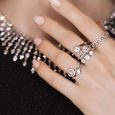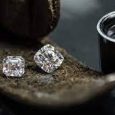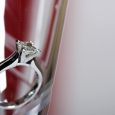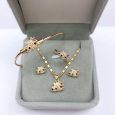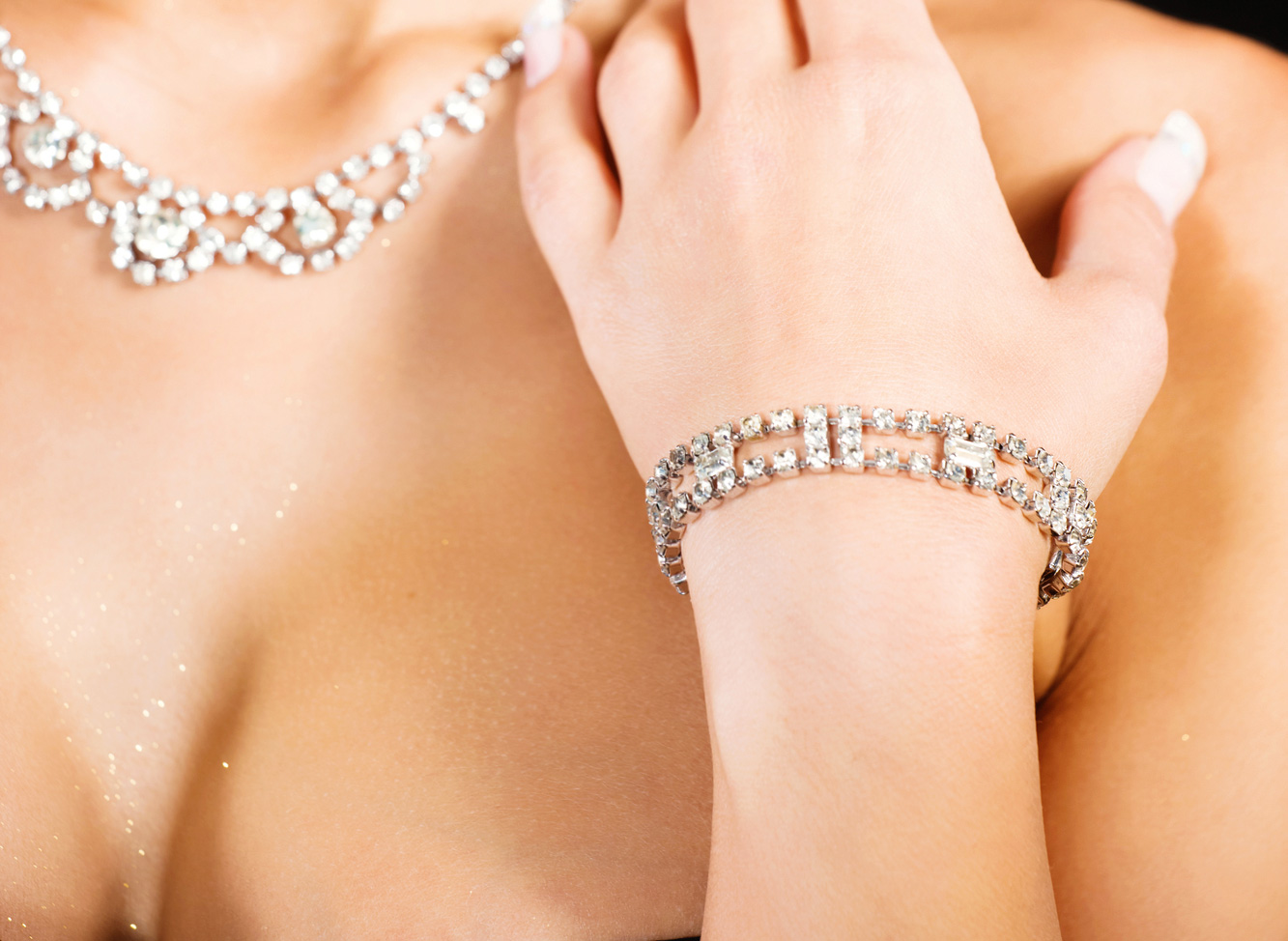
Today consumers are in a better place than ever. With so much valuable access to information on the internet, shoppers can compare and contrast all types of merchandise prior to purchasing to they know for sure that they are making the best and most informed choice with their spending.
This is certainly true when shopping for diamonds too. With so many choices today, buyers need to understand what’s available as well as the pros and cons of each type of diamond. You may have heard the term enhanced diamond but are sure what it is, or if it is right for you.
One thing you’ll want to learn so you can be clear on is that enhanced diamonds are not lab-created diamond look alike. There are so many of those on the market today with many diamonds clarified using laser Drilling or what is known as special laser drilling. If that is what someone wants, then it’s perfectly fine—once they fully understand what they are buying.
But what about the enhanced diamond—what is it anyway? An enhanced diamond is actually a genuine earth mined diamond—and that a very important fact. It came out of the ground like every other true diamond on the market. Where it differs from untreated diamonds is very simple. An enhanced diamond is an earth mined diamond that has been given a very special treatment in the laboratory to eradicate natural inclusions (some people call them flaws or blemishes). These naturally occurring inclusions happen in most every diamond we find. Some have more—some have less. It’s a super rare occurrence for a diamond to be discovered without any inclusions whatsoever. And so, the prices for such diamonds are staggering—only multimillionaires (and more!) can afford those flawless stones.
Top-notch diamond enhancers source good quality diamonds that are lower in the clarity grade—because of their inclusions and they treat them with proprietary techniques that raise the clarity grade. The resulting diamonds are called enhanced or even treated diamonds. And they are spectacular gemstones that anyone can adore. What’s more, they cost less than their natural counterpart. So—the shoppers always get more for their hard-earned money. That’s enough incentive for most astute shoppers to buy a clarity enhanced diamond.
But like any wise shopper, it’s best to learn as much as possible before making that decision. Learn about natural unenhanced diamonds and also the treated or enhanced diamonds. Only you can determine what is the best choice when it comes to selecting your diamond—either an unenhanced diamond or a clarity enhanced stone.
Let’s learn more.
Enhancement Processes for Raising a Diamonds’ Clarity
As most everyone knows today, diamonds have been considered to be among the most highly priced gemstones on earth—something that has been treasured for centuries. Owing to their rarity, beauty and durability, kings and countries have gone to war over them. Of course, they are often the first choice for jewelry especially those of aristocrats and royalty throughout the world. But it’s interesting to learn that as much as they are widely used as jewelry and ornaments, they are also highly valued for use in making industrial tools.

Obviously, the reason diamonds are among the most in-demand precious stones are due to its beauty and durability. But as mentioned previously, colorless and flawless (without inclusions whatsoever) diamonds are extremely rare and almost never occur in nature. Therefore, to meet market demand for real natural diamonds, and also the public’s interest in buying high-clarity diamonds, some diamond producers today buy quality diamonds that are lower on the clarity scale and enhance them. This is even true with naturally colored diamonds today.
Did you know that diamonds are found in the ground with a rainbow of gorgeous hues?
So, the diamond manufacturers are also adding colored diamonds to their inventory and enhancing these remarkable stones too—which appeal to those who follow red-carpet events and see celebrities wearing such jewels. But some shoppers are simply looking for something that no one else has and enhancing both colorless and colored diamonds will improve their overall appearance. There are more than one processes done in the lab today that will enhance both the clarity and the color of natural diamonds.
Understanding Diamond Clarity
When we speak of clarity in diamonds, we are referring to the amount and color of the stone’s blemishes or inclusions that are embedded in the stone. Sometimes Inclusions can make a diamond look very dull—with no life to it—or ‘bounce’ as jewelers say. There are many reasons that inclusions are undesirable. The main thing to know is that these imperfections will interfere with how the light that can pass through the stone. Good light performance will create that sparkly reflection we all admire in a well-cut diamond.
When you go to a jewelry store the next time, take a fresh look at the diamond there—with a new sense of awareness about what a diamond is and how it is cut and polished to reflect light beautifully. Remember not all diamonds are alike. Actually. no two diamonds are exactly the same. They may vary slightly in their carat weight, or have a tiny difference in their cut, or their color for that matter. So, take some time to look at it again–if you look closely at the diamond you’re holding, you be able to see the edges (called facet junctions) where light is reflected back to the eye as it passes through the stone. Any inclusions no matter how minute and nearly invisible to the naked eye has the unwanted effect of lessening the brilliance of that stone because it restricts the way that stone is handling light and being reflected back to the eye. We like to say a diamond sparkles—and that’s the big draw with these stones. But only well cut higher clarity stones are going to have that dramatic light show. Even if a stone hasn’t been clarity enhanced to improve its clarity grade, sometimes jewelers will try to hide these inclusions in the prongs or some part of the mounting, and diamond cutters have to be very careful in cutting the diamonds with inclusions to get the best result. There are all kinds of cutting and setting tricks that veteran bench jewelers employ to get the best possible look from the diamond they have on hand.
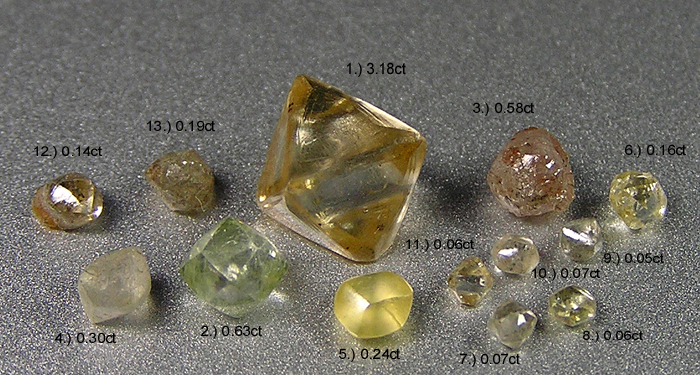
Since shoppers today want all of the characteristics of their diamond to be the best that they can afford, they look over the entire market for both untreated and clarity enhanced diamonds to select the one that meets their preferences and budget, keeping in mind that they want a diamond that looks as dazzling as it can possibly be. For quality diamonds that are perhaps lower on the clarity scale, there are several ways to enhance their clarity today—and that’s a good thing. It only broadens the potential offerings that a consumer has and so make the best choice—rather than settling for something that wasn’t exactly to their taste and budget. Among the widely used processes now, that the public hears about are a color enhancement method, an HPHT (high-pressure, high temperature) laboratory process, plus laser drilling, and what is referred to as fracture filling.
Enhancing the Color
One of the most popular treatments and most widely used processes now is to treat the clarity of a diamond and make color enhancements or color changes as well. This may include treating that particular diamond by using a mask or coating to polish the diamond. In this specialized process, a diamond is given a coating with a matched color—or some color they want to end up with. This process usually involves a super-thin layer of an industrial chemical or a very durable plastic-like material. In certain instances, it has been known that some diamond manufacturers will use synthetic diamonds to mask a tinted area which results in giving the blemished area of the treated diamond a look of an actual colorless stone.
The Process called HPHT
Another well used method of enhancement to the clarity of a diamond is conducted by subjecting it to the HPHT process. The acronym HPHT is an industrial abbreviation that stands for the phrase high-pressure, high temperature. It is during this type of process, that the natural diamond, is subject to a very high pressure and extremely hot temperature in a laboratory setting in order to create a new colored gemstone. Diamonds that appear to be colorless or have several different naturally occurring body colors are subjected to this process in order to create their desired resulting color effect. This specific round of lab treatments can also treat the clarity of a diamond—raising it to a more attractive clarity grade. After being subjected to the HPHT treatment, most naturally occurring blemishes in that diamonds are now barely undetectable.
You will note that the resulting color of that diamond treated via HPHT is permanent as it has been subjected to various acids, ultrasonic treatment plus the high pressure and heat procedure. Incidentally diamonds that have been subjected to HPHT are often much more polished as a result of that surface oxidation appearing on the stone. It is said to restore the brilliance of that diamond, which produces an exceptionally gleaming new look. Sometimes there are consequences of certain methods—and while it may be so negligible that one is not aware of it—it still occurs. Since it has been polished, there is an odd chance that the stone may lose minute amounts of its carat weight.
Let’s Look at Laser Drilling
Another common technique gaining wide acceptance today because of its spectacular results, is to restore the clarity of a diamond via laser drilling the stone. Even though many consumers are not aware of the process, it has been widely used as an important diamond treating method since the early part of 1960s. The main benefit with laser drilling is that it cleans the darkish (either black, brown or colorless) blemishes found inside an otherwise good quality diamond. The inclusions that are eradicated are flaws often composed of other minerals that develop inside the stone while it was being formed millions of years ago deep within the earth. So, while it’s a completely natural occurrence, it can hamper the sparkling brilliance of an otherwise beautiful diamond. These inclusions can be composed of carbon, (which could eventually become diamond in millions of years to come), or even garnet, sulfide, iron or other minerals.
During a laser drilling procedure on a diamond, a special extremely fine laser is positioned directly toward the location of the blemish that is to be removed. Since this is a very exact process, it has to be precise in order to avoid destroying the entire diamond stone. This is where expertise and experience come in to play. Only highly trained laboratory experts can attempt such a procedure with accuracy. If you know anything about microscopic measurements, you’ll be amazed to learn that these laser drills are positioned and set at 1064 nm solid-state. What happens in this treatment is that the laser produces highly-microscopic incisions that root out and clean the imperfections in the area—so a cleaner, clearer stone is produced. So once the laser treatment is finished, the laser drilled diamond reveals a dazzlingly bright clearer to the eye. It’s really quite a remarkable process that renders extraordinary results that appeal to today’s shoppers.
It is thought however, according to some experts, that laser drilling may leave “empty cavities” where once the inclusions were. One can compare it to any other object that had something inside of it cleaned out. In any area where a foreign object has been safely removed from its filled spaces and a certain substance has been eliminated, there can be blank spaces left, no matter how minute or invisible to the naked eye. The resulting cavities are similar in appearance to hollow tunnels inside the stone which may affect its durability. This is where a further process becomes warranted – filling in those crevasses through a specialized method of fracture filling.
Consider the Effects of Fracture filling
Once a diamond has undergone this laser treatment to remove its unattractive internal blemishes, and that process produces an empty space, the next step is to fill the crevasses with a special liquid product to eradicate any appearance of flaws that nature gave it. This will make the stone durable as well as more appealing through its higher clarity. There is always the discussion between some jewelry manufacturers and even amongst collectors that believe treated diamonds to be impure (as contrasted to unenhanced diamonds) and to be of lesser value. To address this concern, diamond collectors and manufacturers in the trade discover the benefits of adding fracture-filling to the process of treatment. It proves to be a win-win situation. The blemishes are successfully removed—and then a specialized filling is added to fill the empty cavities left by the process. Keep in mind, the fracture filling material is very similar to the optical appearance of a diamond—so the lasered space simply disappears and a stunning diamond is created.
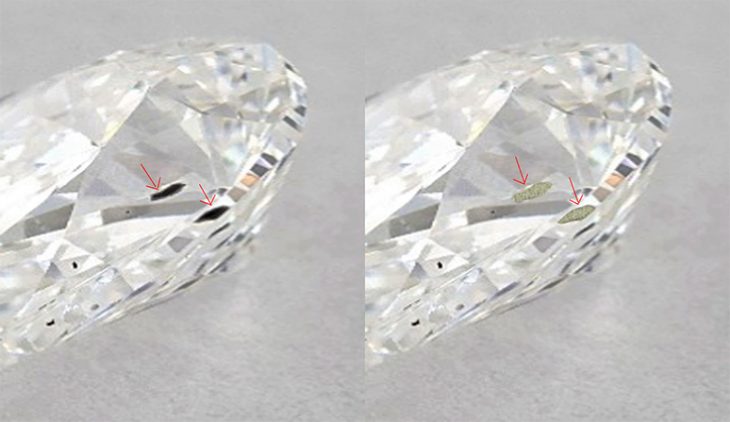
During the fracture filling process, a highly developed and sophisticated material is inserted by intense pressure into each lasered space. thus, hiding the spaces where the imperfections in the gemstone once were. You can imagine that this is a complex and delicate process. It requires precision and expertise in this exact science of fracture filling enhancement to master this type of treatment.
Here’s something you’ll want to know. When this fracture-filling procedure is finished, it will be almost impossible for you or anyone just using the naked eye viewing the stone to distinguish the filling in a diamond That’s exactly what you want in a fracture filled diamond. That means the fracture filling work has done its job to the optimum. Of course, a really skilled diamond master, jeweler or diamond grader can spot the filling upon close examination under the microscope or perhaps with a jeweler’s loupe. There will be discussion that claims that diamonds having undergone a fracture filling are not permanent.
It is also said by some that the fracture filled stones can be compromised, in the event that they become subjected to careless treatment, improper cleaning or even placed under conditions of extreme heat. The owner of a fracture filled diamond must be aware of the care needed to enjoy their diamond for a lifetime. Like any fine precious jewel, there are procedures for keeping it looking its best—they are not difficult to do but should be followed in order to guard the diamond’s beauty for their lifetime.
Because both laser drilling and fracture filling are some of the most prevalent treatment methods in the market today—you will want to know how to identify if a stone has undergone this process. While there are many ways to distinguish a colorless untreated diamond from an enhanced one, it is still wise to consult with a jewelry expert about these diamonds since he or she will have all the needed instruments on hand to examine the stone. This is especially true when you are about to buy an expensive piece of diamond jewelry. The gemological instruments on hand in most reputable jewelry stores will establish exactly what kind of diamond you are considering to purchase—either a treated diamond or its natural untreated counterpart. When you buy a diamond—either enhanced or not from a jeweler, make sure the retailer can provide a certificate detailing if the diamond has been treated or not.
What to Consider When Buying Loose Diamonds
Purchasing loose diamonds is certainly and expensive purchase, and one that needs some well-thought out consideration. If it’s a diamond in your bridal jewelry, it’s not only a sentimental purchase, but one meant to be worn every day for the rest of the person’s life. And it will be treasured more as the years go by. Some like to say it is an investment in the couple’s future, so it’s always wise to choose a diamond that will reflect your special love story as well as hold its value over the long term. The concept of being concerned about the resale value of your diamond at the time of purchase may be far from your mind, still some day you may be interested in selling your diamond for one reason or another, or just trading it in for an upgrade as many couples do. Over time, many people want to memorialize a special anniversary or birth of a child, or other precious life-milestones. Then the consideration of upgrading to a larger stone—even one with a different shape comes into the conversation.
Whenever you consider buying a diamond, it is always best to learn ahead of time as to what contributes to its quality and value—and which attributes are most important to you. Size? Color? Even stone quality are all things to think about ahead of time—before you set foot in the jewelry store. This pre-planning ensures that you make a well-informed purchase—and one you’ll be happy with for years to come. This brings us to the decision of considering an important factor of whether to buy a natural untreated diamond or a treated or enhanced one. The choice is yours and they both have their pros and cons. Ultimately, by learning about enhanced diamonds and their untreated counterparts, when you do go to the store—you won’t have to second guess yourself—and you’ll have the stone of your dreams.
Let’s Talk Natural Diamonds
Diamonds are one of the most fascinating gemstones ever discovered. Not only are they rare, and difficult to mine, but they have been coveted for centuries by rulers of many nations and aristocrats around the globe. Their composition is also unique, making them forever fascinating. Other gemstones are made from various combinations of chemical elements. But did you know that the diamond is the only gem mineral made entirely from a single element—which is carbon. Additionally, diamonds are the hardest known substance in the world, and because of that, both naturally occurring and the lab manufactured variety are valued for their abrasive use. Many diamonds not suitable for jewelry are destined for industrial use. Dental tools, aeronautics, and even deep earth drilling all depend on tools with diamonds embedded in them.
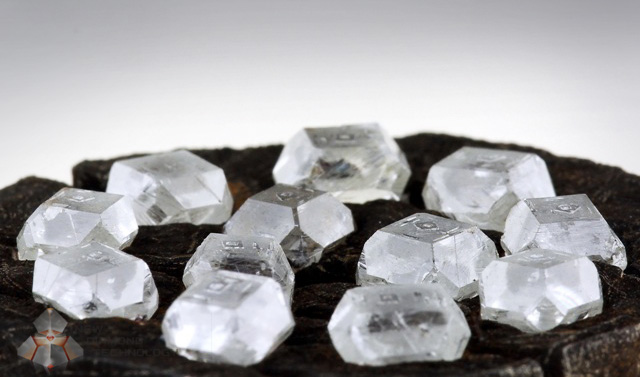
The way diamonds are formed are also amazing to consider. Natural earth mined diamonds are said to form under conditions of enormously high pressure and under very high temperature conditions well below the surface of the earth —from 85 to 125 miles far down in the earth’s mantle. This formative process is certainly a slow one. The simple carbon element under those extraordinary conditions to form a diamond crystal is thought to take somewhere between 1 to 3 billion years to form below the earth. Then the story is not done. Because, after its extraordinary formation, that diamond will have to travel upwards to the earth’s surface via torrents of molten volcanic rock. It is throughout this process that natural diamonds then acquire individual characteristics of this violent formation—called inclusions, blemishes or flaws. These natural traits are part of their creation and are one of the traits that scientists examine to verify if a crystal they are viewing is actually a natural diamond crystal. Because within these distinct markings are found a diamond’s own unique “fingerprint” or telltale signs of creation.
Today consumers have myriad ways to not only shop for diamonds but to learn about them before they make a purchase. The information widely disseminated on the internet allows the shopper to become knowledgeable prior to investing their money in this significant purchase. One can buy in a retail setting or buy online. And both merchants offer different benefits to shoppers. Furthermore, the consumer can determine exactly what kind of diamond is right for them. Diamonds are offered in almost limitless carats sizes, numerous shapes and colors—and at every clarity grade. Some customers will gravitate to natural untreated diamonds and prefer them to enhanced or treated stones because of the romance of their origins and the rarity they may have with their distinguishing inclusion fingerprints. We all understand that no two natural diamonds in the entire world are identical. Even though many may look alike at first glance, in reality each one is unique due to some detail its color or clarity or even the cut and polish of the stone. A trained jeweler can detect the minutest difference in polish details, or symmetry or even the most delicate shape differences—even when looking at two 1-carat diamonds that to the untrained eye will appear identical.
Sorting out Treated or Enhanced Diamonds
Hearing the term “enhanced diamond” may seem like a positive characteristic referenced to a diamond gemstone. Any earth mined natural diamond that is of good quality in its other aspects is a candidate for enhancement to beautify the stone and make it more attractive. The process of being enhanced –or treated does alter it from its original condition via technological advancements in a laboratory to improve its appearance. So, is that a bad thing? Some customers will always say they want a diamond as it came from the earth. And that’s a valid opinion. There’s a certain romantic mystique about that in the eyes of many traditional consumers. So, they have their options to select unenhanced diamonds. Of course, they will be getting smaller diamonds than they might have if they had opted for a treated diamond instead. Many modern shoppers are as fascinated with the technology behind the enhancement processes that markedly improve a diamond’s appearance as others are with the traditional romancing the natural stone.
How to grade and estimate the cost of clarity enhanced diamonds.
If you eventually decide to purchase an enhanced diamond at some point, educate yourself on the grading process and on the kinds of treatments used today and discuss with your jeweler how they might affect the life of the diamond. In other words, knowledge is power. Once you understand how to care for your enhanced diamond because you want it to look as sparkly ten years from now as the day you bought it, it will become second nature to know how to properly care for it. Every precious jewelry owner should be mindful of the long-term care given to their diamond to maintain its appearance. Enhancement treatments may sometimes result in slight discoloration or other adverse effects in the diamond if it has not been correctly cared for.
Whether we are speaking about enhanced diamonds or untreated ones, we are talking about genuine earth mined stones—both having come from the earth at one time. High quality enhanced diamonds on the other hand are natural diamonds that have had proprietary high-tech treatments done to them which improve their clarity grade, so that the once visible natural flaws have now seemingly disappeared.
The type of treatment called laser drilling is of course a procedure that eradicates minor inclusions in a diamond resulting in what we call a clarity enhanced diamond. This method will typically create microscopic lines resembling miniscule trails, so minute that they are only visible under side-view magnification with a microscope or jewelers loupe. Normally, consumers would not be aware of these laser markings, because they are almost imperceptible which is the whole idea of the treatment. Each diamond is completely different of course. So, the laser may dissolve the original imperfections. But when warranted, chemicals may also be injected into the lasered tunnel to further bleach away any residual darkness. This is a more enduring result than simply having fracture filling utilized. However, it is debated as to whether this process may damage the integrity of the stones, so that is a discussion you’d want to have with your jeweler. Let him or her advise if the chemical application has any impact on the integrity of clarity enhanced diamonds for the long term.
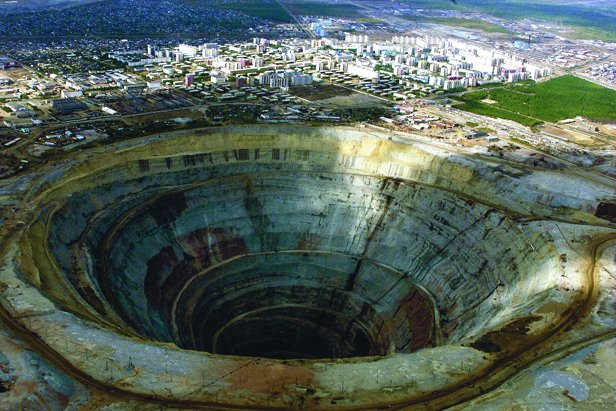
Fracture filling is an interesting treatment in that it deposits a glass-like resin material into the diamond which results in closing its small crevasses. Since the resin filling has the same optical properties and RI (refraction index) as an untreated diamond, it’s almost impossible to perceive where the repair to the inclusions occurred. If you have your enhanced diamond for many years, there may come a time when you need to have it cleaned or repaired for some reason. Keep in mind that fracture filling is not necessarily a permanent treatment in some instances without some care prior to any work being done. High heat from the jeweler’s torch for instance in future repairs, or even with certain cleanings can affect the filler or possibly deepen its color, making the diamond look less than its original brilliant jewel, over time. By adhering to safe cleaning methods and informing your jeweler prior to any work being done on your item, you’ll be sure to have a beautiful diamond for a long time.
With regard to the other type of enhancement process called HPHT (high-pressure high-temperature) it has an interesting history to it. Years ago, General Electric initially developed this laboratory procedure to permanently change the color of a diamond crystal. It was first applied to transform yellowish diamonds into what is called “fancy colored’ diamonds—diamonds with an attractive body color of any hue. Today this method is commonly employed to transform yellow or even brown diamonds into colorless diamonds in order to be more appealing and get a significantly higher price. HPHT requires placing a diamond into a high-pressure chamber and applying high pressure along with very high temperature for a specified time period.
While some industry insiders believe that this HPHT treatment should be considered as a standardized technique, it is thought that this application is simply finishing the job that nature started. Under the earth, the process extreme pressure and ultra-high temperatures was what created diamonds in the first place. According to the Federal Trade Commission, they see the HPHT as an artificial process and as such, mandates the disclosure to consumers. that HPHT. At GIA, the Gemological Institute of America, whenever the HPHT treatment is detected in a diamond, it notes it on the report, referencing it as HPHT annealed or stating artificially Irradiated and requires that such diamonds be laser-inscribed with the that designation for consumer protection. Any diamond that has been enhanced by GE, the forerunner of this technique, will bear the inscription “GE POL”.
Detecting Enhanced or Treated Diamonds
There are a variety of ways one can use to detect if their diamond has undergone any clarity enhancement treatments. As previously stated, laser drilling will result in super thin, whitish channels or lines within the diamond that do not correspond to the patterns of inclusions normally found in loose diamond. When fracture filling is the choice of treatment applied, the stone may appear flawless viewed from the top of the diamond. It is only by careful inspection from the sides or certain other angles that the stone will reveal flashes of rainbow like colors that are distinctly different from the scintillation off the facets in that diamond. Fracture filled diamonds may also have minute air bubbles trapped within that are not visible to the naked eye. These telltale signs are only visible from careful side inspection, so it is critical to examine the stone carefully. A loose diamond of any kind, natural or enhanced is easier to inspect than set into mounting of course.

The Debate Over Enhanced Diamonds
We all know the saying; beauty is in the eye of the beholder—and this old adage has a lot some truth to. You may even find that professionals in the diamond trade are fond of using this same saying to sell their product. But, in the end, the wisest shopper is the informed shopper. Learn all the pros and cons of each type of diamond and discover the one that is beautiful to you. We are all touched by different things. One shopper may look for the largest carat size available and overlook the color of the stone. Another will only be happy with a small but perfectly white stone—with absolutely no body color. Now that you know so much about both types of diamonds—it’s time for you to decide for yourself what is really important in your diamond buying adventure. Size—clarity—color—even shape—the choice is yours. What you deem is beautiful really is—it is the stone that speaks to you.
Why We Like Clarity Enhanced Diamonds
Clarity enhanced diamond are actual earth mined diamonds given a beautification treatment to make them more attractive than they were previously. These diamonds were brought out of the earth just like every other diamond that was ever found. The key difference is they had some treatment applied to them. In the end of course, they cost less than their similar looking untreated counterpart. An enhancement procedure actually does a remarkable transformation of making the stone’s clarity look much higher than it was prior to treatment. And, after the enhancement process is applied, you may end up with a VS2 (Very Slightly Included Diamond) however you’ll likely find that you are only paying for an SI1-SI2 (Slightly Included) price. That is a substantial difference when it comes to buying diamonds. There are very few consumers, even those who avidly collect diamonds, who will actually be able to tell the difference between a clarity enhanced diamond and non-enhanced diamond side by side. And that’s a good thing. Some consumers simply go for the stone that ‘speaks to them’ and collect both natural unenhanced diamonds and those that have had a treatment to them—and they love both of these types of diamonds.

Tough Cookies
Nature’s marvel, the natural diamond is one tough cookie. It can handle many things because only a diamond can scratch another diamond. It’s the world’s toughest natural substance. There’s not much that happen which will really hurt them. They can take some rough handling –although we don’t recommend it—and still sparkle plenty. On the other hand, the glass like resin filler in some treated diamonds is not that relentless, and could, under some circumstances degrade if common sense care is not given. Think about how you wear and enjoy your fine jewelry. Both natural—untreated diamonds can make a good choice—but so can enhanced diamonds if you commit to giving them the care they deserve.
Discovering Clarity Enhanced Diamonds
No matter what kind of treatment was applied to make a diamond more attractive, each clarity enhanced diamond has traits in common, that help tell the story that it has been altered. When you learn to look at your diamond a certain way, you’ll begin to feel like a pro. Because no one just looking at your diamond in its setting will know that it’s a clarity enhanced diamond—except you. Try holding your diamond up to the light especially from the side view–and watch for a pink-toned flash. That tells you that was the exact spot where the fracture filling resin was used to improve its clarity. In nature, diamonds scintillate and sparkle plenty with what seems like all the colors of the rainbow in bright light when they are cut correctly—yet they do not flash pink. The treated diamond radiates all the normal colors you expect plus the pink wink.
